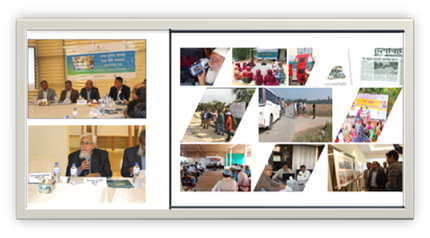Effort Continues for the betterment of the lives of the Displaced Rohingya Population and Host Community in Cox’s Bazar
Starting from August 2017, the large influx of Forcibly Displaced Myanmar Nationals (FDMN) in Cox’s Bazar outnumbered the host community by about 2:1 in the affected Cox’s Bazar Upazilas, posing significant risks of exposure to natural disasters, scarcity of natural resources, crowding and congestion in hat-bazar, roads and other public places. In a bid to address the major challenges in this respect, BCCP was awarded an assignment for “Communication and Awareness Services” by the Local Government Engineering Department (LGED) under the Emergency Multi-Section Rohingya Crisis Response Project (EMCRP) funded by The World Bank.
 The objective of EMCRP is to strengthen the Government of Bangladesh Systems to improve access to basic services and build social resilience among the host community and displaced Rohingya population. Specifically, the project is related with procurement and implementation of building new shelters, improvements of roads, construction of bridge/culverts, some miscellaneous works like drainage structure, hat-bazar, footpath, supply of solar streetlight, firefighting equipment, community centre etc.
The objective of EMCRP is to strengthen the Government of Bangladesh Systems to improve access to basic services and build social resilience among the host community and displaced Rohingya population. Specifically, the project is related with procurement and implementation of building new shelters, improvements of roads, construction of bridge/culverts, some miscellaneous works like drainage structure, hat-bazar, footpath, supply of solar streetlight, firefighting equipment, community centre etc.
The main objectives of the BCCP CAS assignment are to:
§ Complement and strengthen the implementing agency (LGED and DPHE) capacity to undertake BCC.
§ Implement a robust communication strategy to generate awareness and motivate the Displaced Rohingya Population (DRP) to be engaged in activities to benefit from the project interventions.
- Facilitate two-way communication, engagement, and consultations with key stakeholders, including the refugees, host communities, religious leaders, civil society, and other government & non-government agencies.
- Inform the affected communities, including the host community regarding the necessity and the benefits of project interventions with a focus on maintaining social cohesion.
- Address potential resistance and mitigate any evolving risk of opposition. Create broad-based consensus for the project intervention. Communicate project results at local and national level.
As part of project activities, BCCP designed a Communication Strategy, and in line with the strategy, BCCP planned and implemented communication activities with a tagline “Service facilities are mine; I will use them with care; in Bangla “সেবা সুবিধা আমার, যত্নে করি ব্যবহার”. To track the effectiveness of the CAS activities, BCCP designed and implemented an M&E system.
To promote the tagline and generate awareness among the target beneficiaries, BCCP developed some print and audio-visual materials with inputs from the target population at Camps and Host Communities and service providers/frontliners/Volunteers and related program managers like LGED, DPHE, Islamic Foundation, Cyclone Preparedness Program (CPP). Considering the language diversities, each message/material was developed in Bangla (for the Host Communities), English and Burmese (for the FDMN) languages. The materials were used as a tool/aid for communication and awareness generation activities.
Connecting people with local voice: BCCP produced and broadcast 4 episodes of Radio Magazine program with local Community Radio Channel (NAF Radio). The objective of the Radio programs was to enhance awareness and knowledge of Rohingya and Host Community and motivate them to use safe water and ensure appropriate practice on hygienic sanitation and service system; and enhance awareness and knowledge on the Cyclone warning system. The radio episodes were produced following the principles of humanitarian response program and giving emphasis on gender and social cohesion in the local community.
Capacity Building: BCCP conducted a set of need-based training/ workshop/ orientation/ meeting on communication, community mobilization, communication on cyclone warning system, evacuation, and disaster risk management, WASH management & practice, sludge management, etc. to build capacity of the implementing agencies (LGED, DPHE, MoDRM and other volunteer groups) to undertake BCC activities and facilitate two-way effective communication with the DRPs, host communities, religious leaders, civil society, and other key stakeholders.
Communication with community: Implementing a robust communication strategy to generate awareness and motivate the Rohingya and host community to engage them in interventions is very important for ccomprehensive Outreach and Community Mobilization activities. Therefore, Interactive Forum Theatre performance, House to house awareness-raising with branded van and mike, Religious Sermon with Mosque Imam, showcasing of cooking recipes and use of LPG gas, Sports and painting competition for the children, Photo exhibition and discussion were conducted ensuring the involvement of community and local stakeholders.
Media Mobilization: To mobilize media on the EMCRP activities, BCCP conducted some media activities such as Media Visit, capturing success and failure (lessons learned) photo stories, Press Conference, Roundtable Discussions, Social Media Intervention. After the mobilization, BCCP mentored the photographers & photojournalists to capture some of the success stories and lessons learned of EMCRP project. Finally, around 60 photo stories were published in the news media.
It was realized that for bringing synergy among the services and communication and achieving sustainable impacts of the communication and awareness program, and to create more visibility, the activities need to focus more on and need to be backed by need-based resources keeping in mind that the project implementing area is hard to reach and require much time, staff, and more resources compared to other programs at plainland. It is hoped that the extra effort put by BCCP in the outreach intervention will bridge the gap between infrastructure and service visibility and would contribute to community ownership development and sustainable use of the facilities by the Host and Rohingya community in a socially cohesive manner.
